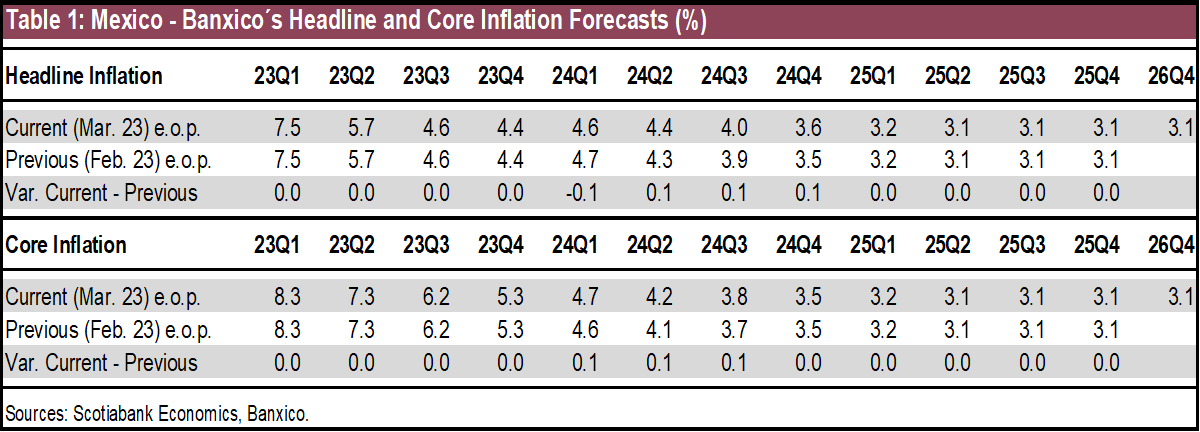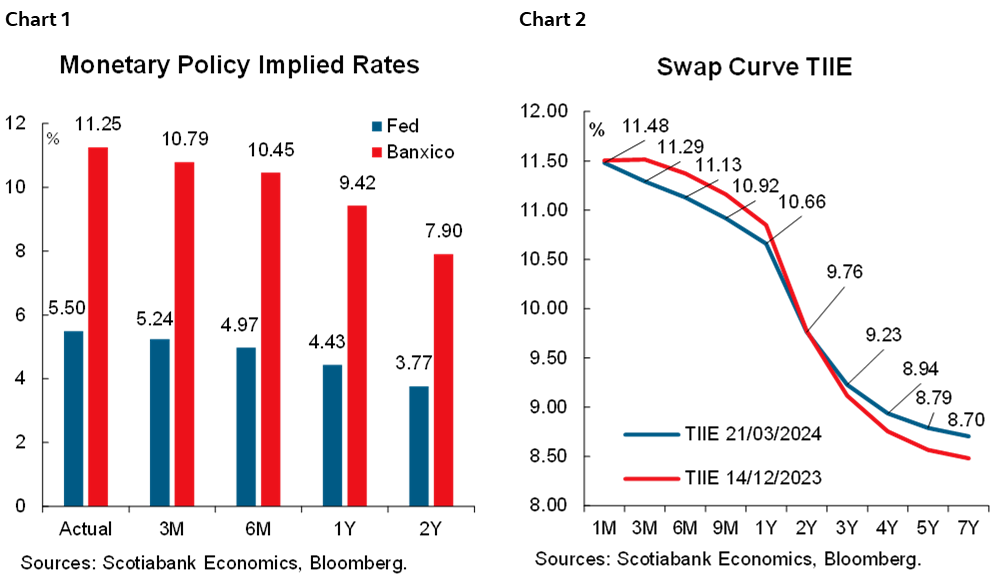- The Board of Governors’ decision was divided, with Deputy Governor Irene Espinosa voting for keeping the rate unchanged.
- Banxico’s forecasts of headline and core inflation rose slightly for the following quarters.
- The statement leaves the door open for a further cut at the May meeting.
Banco de México’s Board of Governors cut the target interest rate for the first time since 2020, from 11.25% to 11.0%, in line with market and analysts’ expectations. However, it revised upward once more the headline and core inflation expectations for the following quarters—now forecasting they will reach the target in 2025 (table 1). The statement stressed that “in the next monetary policy meetings, it will make its decisions depending on available information” leaving the door open to a consecutive cut at the next meeting in May. However, we believe that this cutting cycle will be paused, so we see the next cut as more likely to happen at later meetings.

In February, inflation fell more than expected, after a rebound observed since the last quarter of the previous year, derived from increases in non-core components. Despite this, the slight increase in Banxico’s inflation forecasts suggests a slower disinflationary process going forward. In this sense, the balance of risks in the statement remained biased to the upside, pointing to the stickiness of core inflation, exchange rate depreciation, greater cost pressures, greater than expected resilience in the economy, climate effects, and escalation of geopolitical conflicts. Downside risks remain however, with the possibility of a greater than anticipated slowdown in the global economy, a weaker pass-through of cost pressures, and the impact of a stronger peso so far on mitigating price pressures.
The statement highlighted that, with this decision, the policy stance remains restrictive and conducive to the convergence of inflation to the 3% target. Considering the details of the minutes of the previous meeting, we believe that the argument of some of the members that policy remains restrictive relies on the restrictive stance of the real policy rate, which has increased as inflation declined (the real policy rate is the nominal rate minus inflation). With this, we believe that the Board of Governors has some confidence that inflation will maintain a downward trend and will consider changes in inflation expectations in the following meetings. Thus, we still see some uncertainty in inflation behaviour that could lead to changes in expectations, so we believe it is appropriate to maintain a data-dependent stance.
In the Citibanamex survey, the consensus of analysts anticipates a year-end rate of 9.50%, which implies consecutive 25bps cuts in each of the remaining six meetings of the year, or fewer but larger 50% cuts in case the cycle was to be paused and not continuous. However, some analysts see a year-end rate at 10%, implying a slower cycle of cuts.
As for the exchange rate, it depreciated since this morning but with volatility, as it was observed in a range of $16.67–$16.78, which went on to recover to around $16.72 at the time of the decision. It was more affected by the Fed’s decision yesterday in fact, rising to $16.84 even though the Fed kept its rate unchanged. For the time being, it seems that the peso had already discounted the monetary policy announcement and is shaping up to remain solid despite future rate cuts by Banxico.

DISCLAIMER
This report has been prepared by Scotiabank Economics as a resource for the clients of Scotiabank. Opinions, estimates and projections contained herein are our own as of the date hereof and are subject to change without notice. The information and opinions contained herein have been compiled or arrived at from sources believed reliable but no representation or warranty, express or implied, is made as to their accuracy or completeness. Neither Scotiabank nor any of its officers, directors, partners, employees or affiliates accepts any liability whatsoever for any direct or consequential loss arising from any use of this report or its contents.
These reports are provided to you for informational purposes only. This report is not, and is not constructed as, an offer to sell or solicitation of any offer to buy any financial instrument, nor shall this report be construed as an opinion as to whether you should enter into any swap or trading strategy involving a swap or any other transaction. The information contained in this report is not intended to be, and does not constitute, a recommendation of a swap or trading strategy involving a swap within the meaning of U.S. Commodity Futures Trading Commission Regulation 23.434 and Appendix A thereto. This material is not intended to be individually tailored to your needs or characteristics and should not be viewed as a “call to action” or suggestion that you enter into a swap or trading strategy involving a swap or any other transaction. Scotiabank may engage in transactions in a manner inconsistent with the views discussed this report and may have positions, or be in the process of acquiring or disposing of positions, referred to in this report.
Scotiabank, its affiliates and any of their respective officers, directors and employees may from time to time take positions in currencies, act as managers, co-managers or underwriters of a public offering or act as principals or agents, deal in, own or act as market makers or advisors, brokers or commercial and/or investment bankers in relation to securities or related derivatives. As a result of these actions, Scotiabank may receive remuneration. All Scotiabank products and services are subject to the terms of applicable agreements and local regulations. Officers, directors and employees of Scotiabank and its affiliates may serve as directors of corporations.
Any securities discussed in this report may not be suitable for all investors. Scotiabank recommends that investors independently evaluate any issuer and security discussed in this report, and consult with any advisors they deem necessary prior to making any investment.
This report and all information, opinions and conclusions contained in it are protected by copyright. This information may not be reproduced without the prior express written consent of Scotiabank.
™ Trademark of The Bank of Nova Scotia. Used under license, where applicable.
Scotiabank, together with “Global Banking and Markets”, is a marketing name for the global corporate and investment banking and capital markets businesses of The Bank of Nova Scotia and certain of its affiliates in the countries where they operate, including; Scotiabank Europe plc; Scotiabank (Ireland) Designated Activity Company; Scotiabank Inverlat S.A., Institución de Banca Múltiple, Grupo Financiero Scotiabank Inverlat, Scotia Inverlat Casa de Bolsa, S.A. de C.V., Grupo Financiero Scotiabank Inverlat, Scotia Inverlat Derivados S.A. de C.V. – all members of the Scotiabank group and authorized users of the Scotiabank mark. The Bank of Nova Scotia is incorporated in Canada with limited liability and is authorised and regulated by the Office of the Superintendent of Financial Institutions Canada. The Bank of Nova Scotia is authorized by the UK Prudential Regulation Authority and is subject to regulation by the UK Financial Conduct Authority and limited regulation by the UK Prudential Regulation Authority. Details about the extent of The Bank of Nova Scotia's regulation by the UK Prudential Regulation Authority are available from us on request. Scotiabank Europe plc is authorized by the UK Prudential Regulation Authority and regulated by the UK Financial Conduct Authority and the UK Prudential Regulation Authority.
Scotiabank Inverlat, S.A., Scotia Inverlat Casa de Bolsa, S.A. de C.V, Grupo Financiero Scotiabank Inverlat, and Scotia Inverlat Derivados, S.A. de C.V., are each authorized and regulated by the Mexican financial authorities.
Not all products and services are offered in all jurisdictions. Services described are available in jurisdictions where permitted by law.

